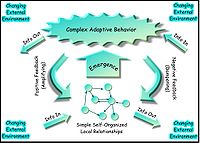
Photo from wikipedia
B‐cell receptor (BCR) signaling is central for the pathomechanism of chronic lymphocytic leukemia (CLL), and inhibitors of BCR signaling have substantially improved treatment options. To model malignant and nonmalignant BCR… Click to show full abstract
B‐cell receptor (BCR) signaling is central for the pathomechanism of chronic lymphocytic leukemia (CLL), and inhibitors of BCR signaling have substantially improved treatment options. To model malignant and nonmalignant BCR signaling, we quantified five components of BCR signaling (ZAP70/SYK, BTK, PLCγ2, AKT, ERK1/2) in single cells from primary human leukemic cells and from nonmalignant tissue. We measured signaling activity in a time‐resolved manner after stimulation with BCR crosslinking by anti‐IgM and/or anti‐CD19 and with or without inhibition of phosphatases with H2O2. The phosphorylation of BCR signaling components was increased in malignant cells compared to nonmalignant cells and in IGHV unmutated CLL cells compared to IGHV mutated CLL cells. Intriguingly, inhibition of phosphatases with H2O2 led to higher phosphorylation levels of BCR components in CLL cells with mutated IGHV compared to unmutated IGHV. We modeled the connectivity of the cascade components by correlating signal intensities across single cells. The network topology remained stable between malignant and nonmalignant cells. To additionally test for the impact of therapeutic compounds on the network topology, we challenged the BCR signaling cascade with inhibitors for BTK (ibrutinib), PI3K (idelalisib), LYN (dasatinib) and SYK (entospletinib). Idelalisib treatment resulted in similar effects in malignant and nonmalignant cells, whereas ibrutinib was mostly active on CLL cells. Idelalisib and ibrutinib had complementary effects on the BCR signaling cascade whose activity was further reduced upon dasatinib and entospletinib treatment. The characterization of the molecular circuitry of leukemic BCR signaling will allow a more refined targeting of this Achilles heel.
Journal Title: International Journal of Cancer
Year Published: 2022
Link to full text (if available)
Share on Social Media: Sign Up to like & get
recommendations!